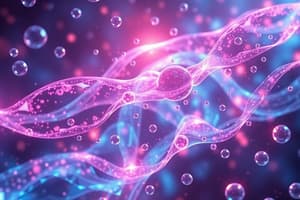Podcast
Questions and Answers
What is the maximum plasma concentration related to in pharmacokinetics?
What is the maximum plasma concentration related to in pharmacokinetics?
Dose, rate of absorption (ka), rate of elimination (k)
What does AUC stand for in pharmacokinetics?
What does AUC stand for in pharmacokinetics?
Area Under the Curve
What is the minimum effective concentration (MEC)?
What is the minimum effective concentration (MEC)?
The minimum concentration of drug in plasma required to produce the desired therapeutic effect.
What does MSC stand for in pharmacokinetics?
What does MSC stand for in pharmacokinetics?
What is the therapeutic range or therapeutic window?
What is the therapeutic range or therapeutic window?
What is meant by the onset of action?
What is meant by the onset of action?
What is the definition of the duration of action?
What is the definition of the duration of action?
What does the fraction of drug absorbed (F) represent?
What does the fraction of drug absorbed (F) represent?
The study dealing with the rate of chemical and physical reactions and their influencing factors is called _____
The study dealing with the rate of chemical and physical reactions and their influencing factors is called _____
In the context of reactions, what is the rate constant denoted as?
In the context of reactions, what is the rate constant denoted as?
What determines the order of a reaction?
What determines the order of a reaction?
What is zero-order kinetics?
What is zero-order kinetics?
Flashcards are hidden until you start studying
Study Notes
Drug Plasma Level-Time Curve
- After a single oral dose, a typical plasma drug concentration-time curve is obtained.
- The curve showcases different phases: absorption, post-absorption, elimination.
- The absorption phase is characterized by the rate constant Ka.
- The peak plasma concentration (Cmax) and time of peak concentration (tmax) are key parameters in this phase.
- The elimination phase is characterized by the rate constant K.
- The therapeutic range is the desired concentration range for achieving therapeutic effects while minimizing side effects.
Pharmacokinetic Parameters
- Cmax: The highest drug concentration achieved in the plasma after administration.
- Cmax is influenced by the dose, absorption rate (ka), and elimination rate (k).
- tmax: The time it takes to reach the peak plasma concentration (Cmax).
- AUC (Area Under the Curve): Represents the total amount of drug absorbed after administration.
Pharmacodynamic Parameters
- MEC (Minimum Effective Concentration): The minimum plasma drug concentration required to achieve the desired therapeutic effect.
- Concentrations below MEC are considered sub-therapeutic.
- MSC (Maximum Safe Concentration): Also known as the Minimum Toxic Concentration, indicating the plasma concentration beyond which side effects occur.
- Concentrations above MSC are considered toxic.
- Therapeutic Range: The range of plasma concentrations between MEC and MSC, ensuring therapeutic effects without significant side effects.
- Onset of Action: The time it takes for the pharmacological response to begin, occurring when the plasma concentration exceeds the MEC.
- Duration of Action: The time period during which the plasma concentration remains above the MEC, maintaining the therapeutic effect.
- F (Fraction of Drug Absorbed): The ratio of the amount of drug reaching the plasma to the total dose administered.
- F value is 1 when all the administered drug reaches the plasma.
- Factors affecting F include: slow drug release, loss of unabsorbed drug, degradation in GIT, and first-pass metabolism.
Kinetics
- The study of reaction rates and factors influencing them.
Rates and Order of Reactions
- Rate: The velocity of a chemical or physical reaction.
- Expressed as the change in drug concentration over time: - dA/dt (forward reaction) or + dB/dt.
- Order of a Reaction: Describes how concentration influences reaction rate.
- Reaction rate = - K * Cn, where:
- dC/dt: rate of reaction
- K: rate constant
- n: order of the reaction (0, 1, 2, etc.)
Zero Order Kinetics
- A constant rate process, independent of drug concentration.
- Increasing drug concentration does not increase the reaction rate.
- An example is alcohol elimination.
Studying That Suits You
Use AI to generate personalized quizzes and flashcards to suit your learning preferences.




